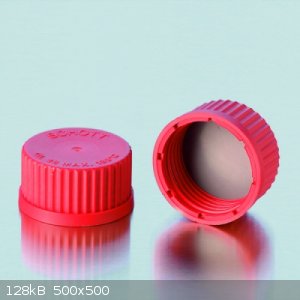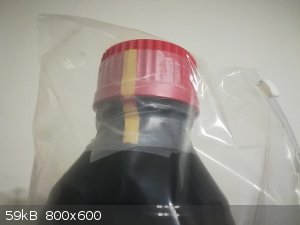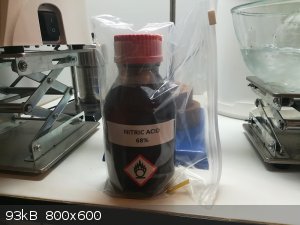Mr. Rogers
Hazard to Others
  
Posts: 184
Registered: 30-10-2017
Location: Ammonia Avenue
Member Is Offline
Mood: No Mood
|
|
Storing HNO3 (corrosion)
Would storing a small amount of HNO3 in a cabinet indoors cause corrosion to metal items like HCl? (Glass bottle with PTFE-lined cap).
|
|
|
Heptylene
Hazard to Others
  
Posts: 319
Registered: 22-10-2016
Member Is Offline
Mood: No Mood
|
|
It depends on the concentration. I'll assume you're talking about concentrated nitric acid (68 %). There is a simple way to test whether the bottle
leaks: put a bit of pH paper on the outside of the bottle. It it turns red, it means acidic vapors are present and must have escaped from the bottle.
Of course you must exclude other sources of acidic vapor around.
I know from this test that 32 % HCl stored in a bottle with PTFE lined GL-45 cap still escapes over time. I usually wrap the neck of the bottle with
Al foil, to act as a sacrificial barrier between HCl and other metal items. After a few weeks, the Al foild is slightly chewed up and brittle.
Al foil won't prevent nitric acid from corroding things, since Al doens't react with nitric acid.
If you were asking whether nitric acid vapor can corode metal things (e.g. steel tools), I don't know but without evidence to the contrary I would
assume it does since it reacts with most metals.
|
|
|
Mr. Rogers
Hazard to Others
  
Posts: 184
Registered: 30-10-2017
Location: Ammonia Avenue
Member Is Offline
Mood: No Mood
|
|
Quote: Originally posted by Heptylene  |
If you were asking whether nitric acid vapor can corode metal things (e.g. steel tools), I don't know but without evidence to the contrary I would
assume it does since it reacts with most metals. |
That's what I'm wondering. I'm sure the vapor is corrosive but I'm not sure if storing it presents the same problems as HCl (which I keep outdoors in
a cabinet meant for pool chems) if kept in a well-sealed bottle.
|
|
|
fusso
International Hazard
    
Posts: 1922
Registered: 23-6-2017
Location: 4 ∥ universes ahead of you
Member Is Offline
|
|
Quote: Originally posted by Heptylene  | It depends on the concentration. I'll assume you're talking about concentrated nitric acid (68 %). There is a simple way to test whether the bottle
leaks: put a bit of pH paper on the outside of the bottle. It it turns red, it means acidic vapors are present and must have escaped from the bottle.
Of course you must exclude other sources of acidic vapor around.
I know from this test that 32 % HCl stored in a bottle with PTFE lined GL-45 cap still escapes over time. I usually wrap the neck of the bottle with
Al foil, to act as a sacrificial barrier between HCl and other metal items. After a few weeks, the Al foild is slightly chewed up and brittle.
Al foil won't prevent nitric acid from corroding things, since Al doens't react with nitric acid.
If you were asking whether nitric acid vapor can corode metal things (e.g. steel tools), I don't know but without evidence to the contrary I would
assume it does since it reacts with most metals. |
Using your logic, maybe OP can try putting scrap pieces of
various non-Al metals (eg Cu, normal steels, stainless, Zn etc) along with a pH paper outside the bottle of HNO3 to see if there are leaks and if it
does, whether the metals corroded or not.
|
|
|
nimgoldman
Hazard to Others
  
Posts: 303
Registered: 11-6-2018
Member Is Offline
|
|
Ideally, nitric acid should be stored separately or at least with other mineral acids, since it is so widely reactive.
It also depends on the concentration. Dilute nitric acid is much safer. Problems come with fuming nitric acid (conc. nitric acid attacks both LDPE and
HDPE - some tables show HDPE having good resistance at 20 °C but it goes down quickly with temperature).
I use glass reagent bottle with the more resistant Duran PBT/Teflon screw cap (see image) and a teflon tape wrapped around the threads (makes better
seal).
I am thinking about a secondary container, at least a bin partially filled with vermiculite and bag to enclose the bottle - you would be able to see
damage if a leak occurs.

|
|
|
Mr. Rogers
Hazard to Others
  
Posts: 184
Registered: 30-10-2017
Location: Ammonia Avenue
Member Is Offline
Mood: No Mood
|
|
Thanks!
What I'm really looking for is not the resistance of the container or closure to HNO3, but if the vapors are prone to escaping like HCl and corroding
nearby metals. This is for 68% conc. HNO3.
[Edited on 12-11-2018 by Mr. Rogers]
|
|
|
Melgar
Anti-Spam Agent
    
Posts: 2004
Registered: 23-2-2010
Location: Connecticut
Member Is Offline
Mood: Estrified
|
|
HCl vapors are actually worse than HNO3 vapors, in my experience. For one thing, aluminum is a really common metal for things to be made out of, and
HNO3 doesn't touch it. Stainless steel either, for that matter. Or chrome-plated steel. HNO3 can escape in small quantities, but doesn't seem to
wage the same vendetta against anything and everything made of metal, like HCl does. HNO3 does corrode certain metals, for sure, so it's not
something you want to be careless with. But it doesn't form a hygroscopic salt that absorbs water and then attracts more acid vapors, so forming more
deliquescent salt and so on, like HCl does. HNO3 can corrode certain plastics though, and can corrode metal by diffusing through paint that you
wouldn't expect it to diffuse through. HCl doesn't really do that.
So all in all, it probably corrodes less than HCl, and corrodes fewer metals, but can attack metals by slowly diffusing through paint and/or plastic
coatings.
edit: The plastics that HNO3 can diffuse through seem to include most plastics that aren't polyethylene or PTFE, and some more than others.
Polyurethane seems especially susceptible.
[Edited on 11/13/18 by Melgar]
The first step in the process of learning something is admitting that you don't know it already.
I'm givin' the spam shields max power at full warp, but they just dinna have the power! We're gonna have to evacuate to new forum software!
|
|
|
Herr Haber
International Hazard
    
Posts: 1236
Registered: 29-1-2016
Member Is Offline
Mood: No Mood
|
|
Remove the pouring ring if present and use the Duran caps suggested and you should have no vapor leak.
Then again, with a full container and in the middle of summer you might leak a tiny bit.
|
|
|
markx
National Hazard
   
Posts: 646
Registered: 7-8-2003
Location: Northern kingdom
Member Is Offline
Mood: Very Jolly
|
|
Quote: Originally posted by Mr. Rogers  | | Would storing a small amount of HNO3 in a cabinet indoors cause corrosion to metal items like HCl? (Glass bottle with PTFE-lined cap).
|
Definately not to the extent of carnage HCl will inflict upon metallic items in the vincinity of the storage location. I've been storing some in a
glass bottle with a proper PTFE lined plastic cap for quite a time and there is no problem with any corrosion of nearby items.
But beware of storing the 68% stuff in a plastic container. I had a Riedel-de Haën variety that came in original plastic vessel and was lengthily
stored on shelf. By grabbing the handle, it broke off like a dry twig.....I had the most fortune this thing did not fall onto the floor and shatter
into a thousand pieces spilling acid everywhere. I managed to decant the contents into a proper glass vessel and avoid the disaster. This makes me
very very suspicious about any corrosive chemicals that are stored in plastic containers....even brand name ones.
Exact science is a figment of imagination.......
|
|
|
AJKOER
Radically Dubious
    
Posts: 3026
Registered: 7-5-2011
Member Is Offline
Mood: No Mood
|
|
Per Melgar: "For one thing, aluminum is a really common metal for things to be made out of, and HNO3 doesn't touch it. " , which is true except if we
are talking about any added exposure to alloys or dust particles with small amounts of copper or Cu(ll) ions or any NaCl presence.
See https://www.researchgate.net/publication/215904038_Reaction_... where complete article is available.
Now, I did say alloys because seemingly theoretical a possible reaction between many metals and HNO3 to form NO or NO2, and further, 2 NO + O2 -->
2 NO2. There is then per Wikipedia a cited creation of anhydrous nitrates via NO2 (see https://en.wikipedia.org/wiki/Nitrogen_dioxide ):
"NO2 is used to generate anhydrous metal nitrates from the oxides:[10]
MO + 3 NO2 → M(NO3)2 + NO"
I say seemingly as on SM a report of using Al foil to seal a NO2 generator resulting in Al(NO3)3 (see my prior comments at http://www.sciencemadness.org/talk/viewthread.php?tid=78678#... ) from the action of NO2 on the Al2O3 coating.
[Edited on 14-11-2018 by AJKOER]
|
|
|
nimgoldman
Hazard to Others
  
Posts: 303
Registered: 11-6-2018
Member Is Offline
|
|
Just my two cents... This shows leakage of NO2 over one day - this is 68% (conc.) nitric acid. The bottle threads are wrapped in Teflon
tape and tightly sealed. The lithmus paper is held over the seal with Parafilm tape. Some NO2 escapes as indicated.
The leak seems not to be in extent required to corrode anything in vicinity, as long as the storage area is large enough and ventilated. It might
become a problem only if concentrated in small area.
I would still store the bottle away from bare metals (Al seem okay) and any chemicals it may react with.
 
[Edited on 16-11-2018 by nimgoldman]
|
|
|
nimgoldman
Hazard to Others
  
Posts: 303
Registered: 11-6-2018
Member Is Offline
|
|
I am now curious how worse the anhydrous stuff would be.
I produce the nitric acid from 98% sulfuric acid and sodium nitrate. The resulting nitric acid is over 99% pure and diluting it is "fun" even in a
fume hood.
Maybe I will vary the process by using dilute sulfuric to already produce dilute nitric...
|
|
|
Sulaiman
International Hazard
    
Posts: 3695
Registered: 8-2-2015
Location: 3rd rock from the sun
Member Is Offline
|
|
anhydrous red fuming nitric acid stores for months at least in a glass sauce bottle with plastic top.
http://www.sciencemadness.org/talk/viewthread.php?tid=90897
No noticeable leakage.
I think that threads should not be wrapped in ptfe (or any other) tape,
sealing is between the cap or its liner - and the smooth top of the bottle.
CAUTION : Hobby Chemist, not Professional or even Amateur
|
|
|
nimgoldman
Hazard to Others
  
Posts: 303
Registered: 11-6-2018
Member Is Offline
|
|
Quote: Originally posted by Sulaiman  | I think that threads should not be wrapped in ptfe (or any other) tape,
sealing is between the cap or its liner - and the smooth top of the bottle. |
Yes I removed the teflon tape and found the NO2 leakage is about the same without it, if not lower.
It seems normal plastic caps are okay at room temperature though are attacked by the acidic vapour and will degrade over (very long) time.
[Edited on 20-11-2018 by nimgoldman]
|
|
|